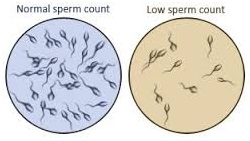Low Sperm Count Causes, Symptoms, Diagnosis and Treatment

What Is Low Sperm Count ?
Also known as oligozoospermia, low sperm count refers to semen with low concentration of sperms. Such semen is ejaculated by a male during an orgasm while having sexual intercourse.
Often such semen may also show significant abnormalities in sperm morphology and motility and is a common symptom of male infertility.
In extreme cases, semen may be wary of sperms at all. Such a condition is dubbed to be azoospermia.
While men with low sperm count may be able to father a child, the chances become low since as the sperm count decreases so does the chance of the sperm combining with an egg.
A low sperm count consists of having sperms lesser than 15 million sperm per milliliter of semen. Such a condition is experienced by up to one fifth of young men.
Causes Of Low Sperm Count:
There can be a number of reasons which may lead to a low sperm count.
Possible causes may include:
- Hormone imbalance
- Hypogonadism marked by the testes producing few or no hormones
- Having an inherited genetic condition
- Klinefelter syndrome
- undescended testicles
- a structural problem pertaining to the male genital tract
- a genital infection
- chlamydia
- Gonorrhea
- Prostatitis
- Having had surgery of the scortum
- Having dilated veins within the testicles
- Medications
- testosterone replacement therapy,
- long-term anabolic steroid use
- cancer medications
- ulcer medications
- exposure to chemicals such as pesticides
- using drugs
A number of factors increase the risk of developing low sperm count. They include:
- Being a tobacco smoker
- Alcohol consumption
- Use of illegal drugs
- obesity
- Overheating the testicles
- trauma to the testicles
- Being born with a fertility disorder or having a blood relative with a fertility disorder
- Having certain medical conditions, including tumors and chronic illnesses
- Having a prior vasectomy or major abdominal or pelvic surgery
- Having a history of undescended testicles
Symptoms Of Low Sperm Count:
The following signs and symptoms may be exhibited:
- Inability to conceive a child
- low sex drive
- (erectile dysfunction
- Pain, swelling or a lump in the testicle area
- Decreased facial or body hair
Diangosis Of Low Sperm Count:
The following diagnostic tests should be conducted in order to diagnose low sperm count:
- Medical history and physical examination
- Semen analysis
- Scortum ultrasound
- Hormone testing
- Genetic testing
- Trans rectal ultrasound
Treatment Of Low Sperm Count:
The following treatment options are available:
- Surgery
- Hormone treatment and medications
- Assisted reproductive technology
- Treatment for problems with sexual intercourse
By : Natural Health News




